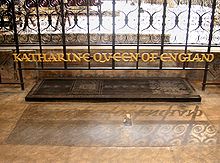 Catherine of Aragon, first wife of Henry VIII, died on 7th January 1536 and was buried as the Dowager Princess of Wales, the title which she herself had never recognised, at Peterborough’s Benedictine abbey on 29th January 1536.
Catherine of Aragon, first wife of Henry VIII, died on 7th January 1536 and was buried as the Dowager Princess of Wales, the title which she herself had never recognised, at Peterborough’s Benedictine abbey on 29th January 1536.
In his recent biography of Catherine of Aragon, Patrick Williams gives details of the preparations for Catherine’s burial. After her body had been disembowelled by one of her servants, her body was taken to the Privy Chamber at Kimbolton, the castle which had been Catherine’s home since May 1534, where it was placed under a canopy of state. It remained that way until 15th January when it was finally encased in a lead coffin, in preparation for burial, and taken to the castle’s chapel, where it stayed until 27th January.
Williams writes of how solemn masses were said while Catherine’s remains were in the chapel and that these masses were attended by noble ladies like the Duchess of Suffolk and the Countesses of Worcester, Oxford and Surrey. On 26th January, a formal dinner was held with the Countess of Surrey acting as chief mourner. On 27th January, a mass was celebrated and then Catherine’s coffin began its journey to Peterborough. Williams describes how the procession consisted of a crucifer, sixteen priests and gentlemen, Catherine’s chamberlain and steward carrying their rods of office, around ten heralds wearing mourning hoods, the wagon bearing the coffin and escorted by thirty-six maids and fifty servants of the gentlemen all carrying torches, seven ladies acting as chief mourners, and nine ladies who were the wives of local knights.
The procession halted at Sawtry Abbey, nine miles from Kimbolton, and Catherine’s coffin was taken to the choir of the church there and placed under a canopy. Williams describes how Abbot William Angell burned 408 candles in an overnight vigil.
On 28th January, a mass was led by Thomas Goodrich, Bishop of Ely, before the coffin set off on the last leg of its journey to Peterborough. At Peterborough Abbey, Abbot John Chambers and the Bishops of Lincoln, Ely and Rochester greeted the procession at the abbey door and then the coffin was processed to the mourning chapel which was “lavishly hung with eighteen banners which emphasised Katharine’s status in the royal families of England and Spain: among them were those of Charles V, Henry VIII, Queen Isabella and Prince Arthur, Katharine’s sister, the Queen of Portugal; those of Castile, Aragon, Sicily and England; and that of John of Gaunt.” There were also pennants displaying the arms of Catherine and her father, Ferdinand II of Aragon, and golden letters spelled out her motto “Humble and Loyal”. Catherine was buried on 29th January with Eleanor Brandon, daughter of Charles Brandon, Duke of Suffolk, acting as chief mourner and Sir William Paulet representing Henry VIII. John Hilsey, Bishop of Rochester, preached the homily “speaking against the power of ‘the Bishop of Rome’ and the marriage of Katharine and Henry VIII” and “insisting that she had never been Queen of England”. Catherine’s chaplain, George de Athequa, Bishop of Llandaff, was, however, allowed to serve one of the masses said at Peterborough as deacon.
It seems such a sad end to a woman who was Queen for nearly 24 years. She died away from court and separated from her daughter, and was buried as Dowager Princess, not Queen, and her funeral arrangements were rushed and appeared to be an afterthought. However, Catherine may have been buried as Dowager Princess in 1536 but today she is recognised as Queen. The railings behind the stone slab marking her resting place are decorated with the words “Katharine Queen of England”. According to her biographer, Giles Tremlett, an appeal in the 19th century to women in England named Catherine/Katherine raised enough money to replace the stone slab and in 1986 a wooden plaque reading “A queen cherished by the English people for her loyalty, piety, courage and compassion” was added.
Each year, the anniversary of Catherine’s funeral is commemorated by a special service at Peterborough Cathedral (the former abbey) attended by the present Spanish ambassador, and her tomb is decorated with flowers and pomegranates. An itinerary of Tudor-themed events is also planned each year and has become known as the “Katharine of Aragon Festival”.
Notes and Sources
- Williams, Patrick (2013) Katharine of Aragon, p375-376
- Tremlett, Giles (2010) Catherine of Aragon: Henry’s Spanish Queen, p426